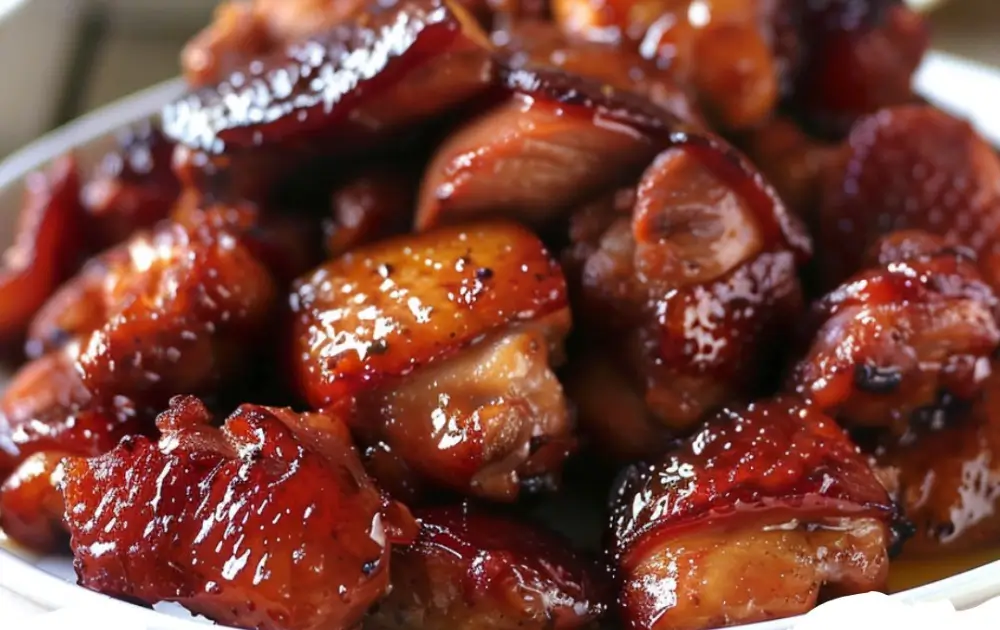icken Tocino originates from the Spanish word “tocino,” meaning bacon. Traditionally made with pork, this Filipino dish has adapted to include chicken for a lighter version. The method of making tocino involves curing the meat with sugar, salt, and various spices, which imparts a uniquely sweet and savory flavor. Originally, this process was a practical way to preserve meat in the tropical climate of the Philippines, before the advent of refrigeration.
Print
Chicken Tocino
- Total Time: 30 minutes
- Yield: 4 servings
- Diet: Gluten Free
Ingredients
– 900g chicken thighs, boneless and skinless, thinly sliced
– 120ml pineapple juice (for tenderizing and adding a slight tang)
– 100g brown sugar (for sweetness and caramelization)
– 60ml soy sauce (for color and saltiness)
– 1 tablespoon garlic, minced (for aroma and flavor)
– 1 teaspoon salt
– 1 teaspoon ground black pepper
– 1 teaspoon annatto powder (achuete) for color (optional)
– Cooking oil, for frying
Instructions
1. Prepare the Marinade:
– In a large bowl, combine pineapple juice, brown sugar, soy sauce, minced garlic, salt, pepper, and annatto powder if using.
– Mix well until the sugar is dissolved.
2. Marinate the Chicken:
– Add the chicken slices to the marinade, ensuring each piece is well coated.
– Cover the bowl and refrigerate for at least 4 hours, preferably overnight, to allow the flavors to meld.
3. Cook the Tocino:
– Heat a skillet over medium heat and add a small amount of cooking oil.
– Fry the marinated chicken slices in batches, turning occasionally, until fully cooked and caramelized on both sides. The sugar in the marinade will caramelize, giving the tocino its characteristic sweetness and a beautifully glazed appearance.
4. Serve:
– Serve the chicken tocino hot with a side of garlic fried rice (sinangag) and a fried egg for a traditional Filipino breakfast known as “Tocilog.”
Enjoy the delicious and authentic Filipino flavor of Chicken Tocino!
Notes
- For a healthier version, substitute brown sugar with honey or a sugar-free sweetener.
- Annatto powder can be substituted with paprika for color, though it will slightly alter the taste.
- Gluten-Free (check soy sauce for gluten).
- Prep Time: 15 minutes
- Cook Time: 15 minutes
- Category: Main Course
- Method: Marinating, Pan-frying
- Cuisine: Filipino
Nutrition
- Calories: 300
- Sugar: 16g
- Sodium: 900mg
- Fat: 15g
- Saturated Fat: 4g
- Carbohydrates: 18g
- Fiber: 0g
- Protein: 22g
- Cholesterol: 85mg
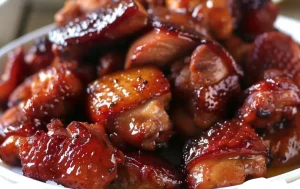
Frequently Asked Questions (FAQs)
Can Chicken Tocino be made without sugar?
Yes, Chicken Tocino can be made without traditional sugar by substituting it with natural sweeteners like honey, agave syrup, or artificial sweeteners. These alternatives can provide the necessary sweetness while catering to dietary preferences or restrictions.
Is there a quicker way to marinate Chicken Tocino?
While the traditional marinating time ranges from 12 to 24 hours, using a vacuum sealer can speed up the process. The vacuum sealing method allows the marinade to penetrate the chicken more quickly, effectively reducing the marinating time by half.
How do I ensure my Chicken Tocino is cooked thoroughly but remains juicy?
To ensure thorough cooking while keeping the tocino juicy, use a medium heat and cover the pan with a lid after adding a small amount of water. This method helps steam the chicken, maintaining its moisture while ensuring it is cooked through.
Can I grill Chicken Tocino?
Absolutely, grilling is a fantastic way to cook Chicken Tocino. Grilling over medium heat allows the sugars in the marinade to caramelize beautifully, adding a smoky flavor that enhances the dish. Just be sure to frequently turn the chicken to prevent burning.
What are some common side dishes to serve with Chicken Tocino?
Common sides include garlic fried rice, sunny-side-up eggs, and a tangy pickled papaya salad. These sides complement the sweet and savory flavors of the tocino, making for a balanced meal.
Ingredients and Preparation
To prepare Chicken Tocino, you begin with boneless chicken thighs or breasts, which are more flavorful and tender when cooked. The chicken is typically cured with a mixture of sugar, salt, pineapple juice, and annatto powder, which gives it a distinctive red color. Garlic and pepper are also added for extra flavor. The meat must cure in the refrigerator for about 12 to 24 hours to ensure it absorbs the flavors thoroughly.
Cooking Techniques
Once the chicken has marinated, you cook it by pan-frying. The key to perfect Chicken Tocino lies in the frying technique. The chicken should be fried slowly over medium heat, allowing the sugar in the marinade to caramelize without burning. Occasionally, a small amount of water is added to the pan to help the meat cook evenly and prevent it from drying out. This also creates a rich, sticky sauce that coats the chicken beautifully.
Serving Suggestions
Chicken Tocino is traditionally served for breakfast in the Philippines, often as part of a larger meal that includes garlic rice and fried eggs, commonly referred to as “Tosilog” – a portmanteau of tocino, sinangag (garlic rice), and itlog (egg). This combination balances the sweetness of the tocino with the savory elements of the meal. For a complete dining experience, a tangy vinegar dipping sauce or a side of pickled papaya (atcharang papaya) is often served to cut through the sweetness.
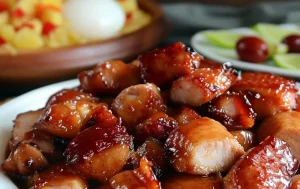
Variations and Modern Adaptations
In recent years, health-conscious adaptations of Chicken Tocino have emerged, utilizing alternative sweeteners like honey or agave instead of refined sugar. Some cooks also experiment with different types of citrus or pineapple juices for curing to add unique twists to the traditional flavor profile. These variations cater to a broader audience, including those looking for healthier or more nuanced versions of this beloved Filipino dish.
Nutritional Information
Chicken Tocino provides a mix of protein and carbohydrates, primarily from the chicken and the sugar used in the marinade. Since chicken is a leaner alternative to pork, this version of tocino is generally lower in fat, making it a somewhat healthier option. Each serving typically contains a significant amount of protein, which is essential for muscle repair and growth. However, due to the sugar content, it is also relatively high in calories and carbohydrates, which should be considered if one is monitoring their intake for health reasons.
Health Considerations
Consuming Chicken Tocino in moderation is crucial due to its high sodium and sugar content. Excessive intake of sodium can lead to hypertension and other cardiovascular issues, while high sugar intake is linked with an increased risk of diabetes. To make a healthier version, one can reduce the amount of salt and sugar or substitute sugar with natural sweeteners like honey. It is also advisable to use lean cuts of chicken to minimize fat content further.
Culinary Pairings and Side Dishes
Chicken Tocino pairs excellently with various side dishes that balance its sweet flavor. A popular choice is achara, a Filipino pickled papaya salad, which provides a tangy contrast. Steamed rice cleanses the palate between bites, while a fresh cucumber salad can add a crisp texture and refreshing taste. For those looking for a more robust meal, pairing tocino with a vegetable stir-fry featuring bell peppers, onions, and snap peas can add both color and nutritional balance to the meal.
Cultural Significance
In the Philippines, Chicken Tocino is not just a meal; it represents a fusion of Filipino and Spanish culinary traditions, showcasing the lasting impact of Spanish colonization on Filipino cuisine. It is a staple at festive occasions and family gatherings, reflecting the communal nature of Filipino dining culture. Preparing and eating tocino is a culinary practice that strengthens family bonds and celebrates heritage, making it more than just food but a part of cultural identity.
Cooking Tips and Techniques
To achieve the best flavor and texture in Chicken Tocino, it is important to marinate the chicken thoroughly to ensure that the flavors penetrate deeply. Cooking the chicken at a controlled temperature helps prevent the outside from burning before the inside is cooked through. A non-stick pan or a well-seasoned skillet can reduce the need for additional oil, making the dish healthier. Lastly, allowing the tocino to rest for a few minutes after cooking will help distribute the juices evenly, ensuring that every bite is moist and flavorful.
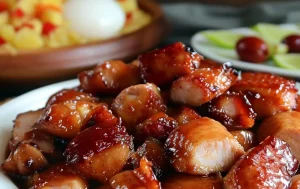
Storage and Shelf Life
Chicken Tocino requires proper storage to maintain its quality and safety. Once cured, the chicken should be kept in the refrigerator and ideally used within three to five days to ensure freshness. For longer storage, freezing the marinated chicken is an effective option. Frozen tocino can last up to three months if stored in airtight containers or freezer-safe bags. To use, it should be thawed overnight in the refrigerator before cooking. It is crucial to avoid refreezing previously thawed tocino to prevent bacterial growth and quality degradation.
Batch Cooking and Freezing
Preparing Chicken Tocino in large batches can save time and provide a convenient meal option for busy days. After marinating, portion the chicken into meal-sized servings and freeze each portion separately. This approach allows for easy and quick meal preparation, as only the needed amount can be thawed and cooked. When freezing, ensure all air is removed from the storage bags to prevent freezer burn, which can affect texture and taste.
Dietary Adaptations
For those with dietary restrictions, Chicken Tocino can be adapted to suit various needs. Abouta lower-sodium version, reduce the amount of salt in the curing mixture or use a salt substitute. For diabetics or those avoiding refined sugars, natural sweeteners like stevia or monk fruit can replace traditional sugar. Additionally, gluten-free soy sauce can be used if gluten is a concern. These substitutions allow individuals to enjoy the flavors of tocino without compromising their dietary guidelines.
Cooking for Large Groups
When cooking Chicken Tocino for large groups, it is important to consider batch size and cooking method to ensure even cooking. Using multiple pans or cooking in batches can help manage this. Keeping cooked tocino warm in an oven set at a low temperature helps when serving large numbers. It’s also beneficial to prepare sides like rice and vegetables in advance, allowing the focus to remain on cooking the tocino to perfection.
Flavor Enhancements
Experimenting with additional flavors can elevate Chicken Tocino to new culinary heights. Incorporating ingredients like orange zest or lemongrass into the marinade can introduce a fresh, citrusy note that complements the sweet profile of the tocino. For a spicier version, adding crushed red pepper flakes or freshly minced chili peppers can provide a nice heat that cuts through the sweetness. Trying different wood chips for smoking tocino can also add a depth of smoky flavor that enhances the traditional taste.
Enhancing Meal Presentation
Chicken Tocino not only tastes delightful but can also be presented in visually appealing ways to enhance the dining experience. Plating the tocino alongside a colorful array of side dishes, such as vibrant green bok choy or sunny yellow mango slaw, creates an inviting contrast. Drizzling a little of the caramelized cooking sauce over the chicken adds a glossy, appetizing sheen. Garnishing with fresh herbs like cilantro or green onions can add a fresh pop of color and flavor that complements the sweet and savory profile of the dish.
Utilizing Leftovers
If there are leftovers, Chicken Tocino can be creatively reused in various dishes. It can be shredded and added to omelets or breakfast burritos for a hearty start to the day. Another option is to chop the tocino and incorporate it into fried rice or a noodle dish for a quick and flavorful meal. These variations not only reduce food waste but also provide a new way to enjoy the delicious flavors of tocino in different culinary contexts.
Pairing with Beverages
Selecting the right beverages to accompany Chicken Tocino can enhance the meal’s flavors. For a non-alcoholic option, a sparkling pineapple or mango juice complements the sweetness of the tocino while refreshing the palate. If alcohol is permissible, a light, fruity white wine like Riesling or a crisp pilsner can balance the richness and sweetness of the dish, making for a harmonious dining experience.
Educational Cooking Classes
Offering cooking classes focused on making Chicken Tocino can be an excellent way for culinary enthusiasts to learn about Filipino cuisine. These classes can cover the basics of curing and cooking the tocino, along with tips on ingredient substitutions and presentation techniques. Participants can also learn about the cultural significance of the dish, providing a deeper appreciation for the flavors and history behind tocino.
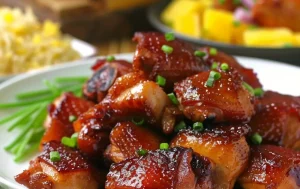
Seasonal Variations
Adapting the recipe to incorporate seasonal ingredients can make Chicken Tocino an exciting dish all year round. In the summer, adding fresh mangoes or peaches to the marinade can infuse it with a sweet, tangy flavor that’s perfect for the season. During the colder months, introducing spices like cinnamon or nutmeg can add a warm, comforting element to the dish. These seasonal twists not only keep the dish interesting but also cater to the availability of local, seasonal produce, enhancing the overall flavor and sustainability of the meal.
Conclusion
Chicken Tocino is a versatile and flavorful dish that holds a cherished place in Filipino cuisine. Whether enjoyed in its traditional form or adapted to meet modern dietary needs, it offers a delightful blend of sweet and savory flavors that can be enjoyed in various meals throughout the day. By exploring different cooking methods, ingredient variations, and seasonal adaptations, you can keep this beloved dish exciting and fresh for any occasion.

